Top 11 Teamwork Alternatives (Pad & Free): 2025 Review
In case you’re looking for Teamwork alternatives that fit your workflows and budget, you’re at the right place.
This guide compares the top 11 substitutes with pros, cons, user reviews, and practical use cases across views, dashboards and reporting, and resource management.
What Are the Best Teamwork Substitutes in 2025?
The best Teamwork substitutes in 2025 are Productive, Asana, Trello, Basecamp, ClickUp, Workzone, monday.com, Wokamajig, Avaza and Easy Project.
Below is the top tool replacement list with, with descriptions for each alternative. Feature lists, pros, cons, and user reviews are in the sections below.
1. Productive – Teamwork Alternative For All-in-One Project Management
Productive is our pick among Teamwork alternatives for teams that need one platform to connect project management, budgets, time, resources, and reporting.
It centralizes planning and time tracking with resource management, so leaders see workload, costs, and projected margin as work moves. Built-in and custom dashboards, advanced reporting, billing and invoicing replace spreadsheet exports and manual reconciliations.
An overview of Productive vs Teamwork benefits include:
- Productive offers more robust reporting and financial forecasting. For example, with Teamwork, many advanced features are included only in the highest-paid plans and there’s no integration with Xero for invoicing (only QuickBooks).
- Productive offers an integrated sales pipeline with customizable deal stages, sales performance tracking, and more. With Teamwork, you’ll need to pay for a separate tool.
- With Productive, you’ll also get some additional and/or expanded features. This includes integrated time-off management, expanded budget creation (markup, reimbursement, non-billable expenses), and tentative bookings to schedule for unconfirmed projects.
Additionally, when compared to Productive, Teamwork is a more expensive solution.
Try Productive as your Teamwork alternative
Get True Project Visibility
Projects run smoother when everyone can spot risks early and agree on what comes next. In Productive, your plan lives in one place, with project management views that show Gantt charts, milestones, and task dependencies in context.
And yes there’s also a calendar view.
You see where work connects, what might slip, and which dates actually need to change.
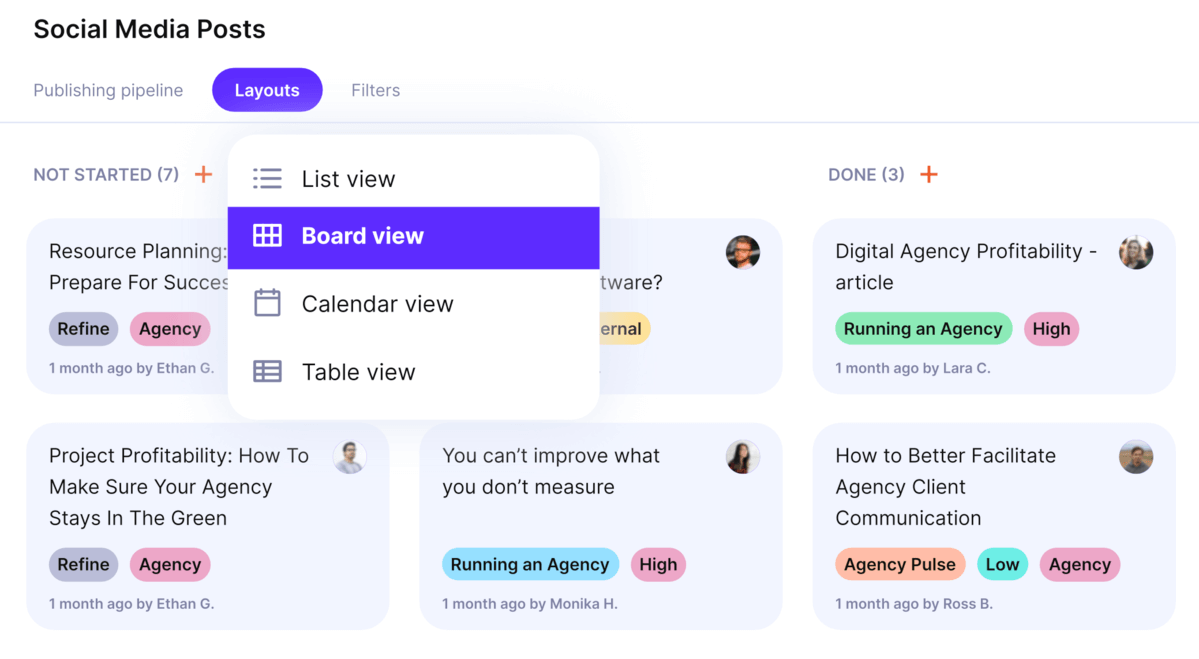
Use Productive’s Kanban boards and Gantt charts for visual task management.
When feedback is needed, invite clients to a specific project for free. They see only what you share, so reviews and approvals happen in the right thread without extra tools.
From there, assign owners, set dates, and keep updates flowing in the same view.

THE WORKLOAD VIEW MARRIES RESOURCING AND TASK MANAGEMENT IN ONE LAYOUT
Use the cross project milestone view to identify which dependent tasks will slip, then update the parent date once instead of adjusting three separate timelines. Track the on time milestone rate and the overdue task trend to confirm improvement.

Gantt chart
Keep Teams Accountable and Aligned
Productive’s task management keeps work organized in task lists with owners, priorities, and due dates.
You can also split your projects up into project phases. From there you make things event more easier by setting up dependent tasks and subtask dependencies. In a few clicks you can manage and visualize relationships between tasks (which tasks are blockers, which need to be finished for another to get underway, etc.).

MANAGE YOUR TASK UPDATES, BILLABLE HOURS, AND COLLABORATION IN ONE SCREEN
When you communicate directly on tasks, you keep the conversation with the work. Since comments and docs live on the task (and not scattered across tools) project managers have a better task tracking overview of what your project teams are doing and if they’ve encountered any problems.
For repeating routines, set recurring tasks so weekly and monthly checklists don’t get skipped. When you clear a blocker, dependent tasks unlock and the team moves forward together. You just have to track blocked tasks resolved per week and cycle time to confirm flow is improving.
Easy To Use Time Tracking for Reliable Billing and Predictable Utilization
Time tracking isn’t the most exciting of tasks, but it still needs to be done because knowing where and how your billable time goes keeps budgets honest and improves utilization.
With Productive, time management is super simple. It’s easy as starting a timer on the task, or adding time manually at day’s end. You can also convert Google Calendar events into time entries linked to the right project.
Set weekly approvals so billable hours are reviewed before invoicing. That simple optimization reduces rework, saves reporting time and protects margins.
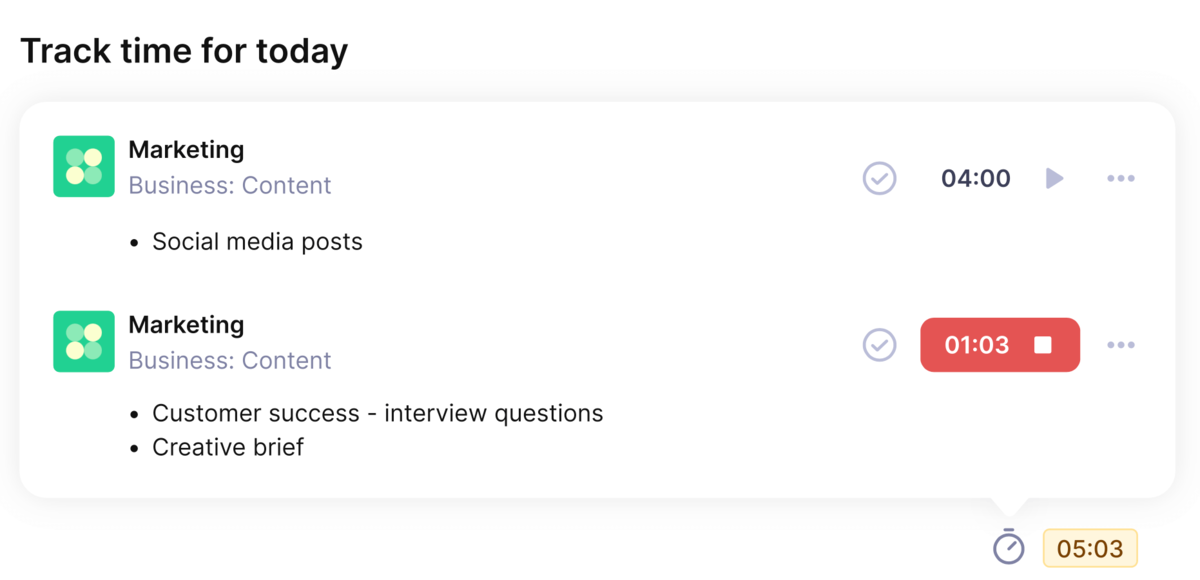
Gantt chart
Use the desktop app to start or stop time from the menu bar, and the mobile app when you’re away. And that’s it.
Balance Workloads With Live Capacity
Seeing capacity next to the plan prevents overbooking. In Productive, the workload view shows who has room and who is at risk, with capacity indicators that respect time off.
You can also use tentative bookings to hold space for likely work without locking the schedule. Replace placeholders with a new hire or contractor and watch availability update in real time.

Gantt chart
Bonus resource allocation tip: Aim for fewer over-allocated hours and steadier utilization. Then, track capacity over-allocation rate and utilization predictability to confirm improvement.
Make Budgets Visible and Margins Predictable
Budgeting only work when they reflect real scope and real rates. In Productive, you set fixed price, hourly, or retainer models, then include markup, reimbursements, and non billable costs so estimates match reality.
Profit margin is visible from day one because time and costs feed the same budget.
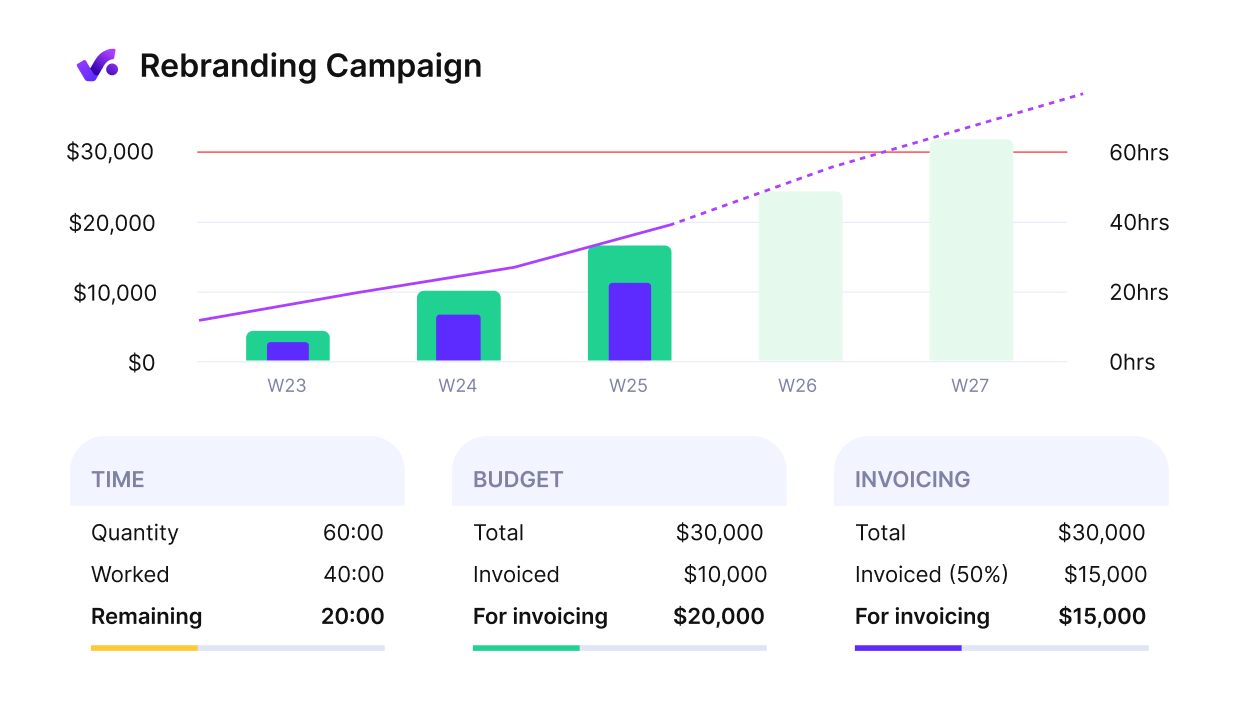
Get an early warning in case of budget overruns.
You can also get an overview of your company’s total profitability (or its subsidiaries) and manage revenue recognition. Forecast your revenue and see when you’re about to go over budget.
In case these forecasts show a retainer trending over, you’ll see it mid cycle and adjust scope or funding before month’s end.
Productive also offers built-in client invoicing. Handle the process on the platform or copy data from Productive into QuickBooks or Xero and take it from there.
You can check out how Brigada increased project profitability with Productive.

Make the right choices with the right reports
Reporting with Real-time Dashboards and Whithout Spreadsheets
With Productive’s Reporting, you can make insightful reports that’ll help you make better business decisions. You can create reports by selecting a template from our library of 50+ agency-focused reports or by building your own from scratch.
You can also build flexible dashboards and populate them with your chosen real-time reports.
Roll up performance across clients and projects for portfolio reporting. That gives leaders one source of truth and faster decisions. Track time to produce reports, report adoption, and time to decision to confirm it works.
Otherwise, you can also schedule automatic sending to Slack or email with Productive’s notification system, called Pulse.
Additional Features Include:
- An integrated Sales CRM feature that includes a customizable pipeline stages, building and sending proposals, sales team scheduling and revenue forecasting.
- No-code workflow Automations for simplifying repetitive tasks and processes.
- Custom Permission Builder to control who can see and do what on the platform.
Integrations
Productive offers an expanded range of built-in integrations with other productivity and finance tools.
These include Xero and QuickBooks for accounting; Slack, Google Calendar, and Memtime for collaboration and timetracking; Breathe and BambooHR for HR management; HubSpot, Jira, Zapier, and many more.
Pricing
- Plans start with the Essential plan at $9 per user per month, which includes essential features such as budgeting, project & task management, docs, time tracking, expense management, reporting, and time off management.
- The Professional plan includes custom fields, recurring budgets, advanced reports, billable time approvals, and many more for $24 per user per month.
- The Ultimate plan has everything that the Essential plan and Professional plan offer, along with the HubSpot integration, advanced forecasting, advanced custom fields, overhead calculations, and more for $32 per user per month.
You can go for a free 14-day free trial before you decide to check out a paid plan.
Find the Perfect Alternative to Teamwork
Support your agency’s growth with an intuitive solution for comprehensive agency management.
2. Asana – Structured Teamwork Competitor for Cross-Functional Teams
Asana is a popular online project planning tool that allows teams to manage tasks, track progress, and collaborate on projects in real-time. Some of the key features of Asana include:
- Project and Task Management
- Task Lists
- Dashboards and Reports
- Integrations
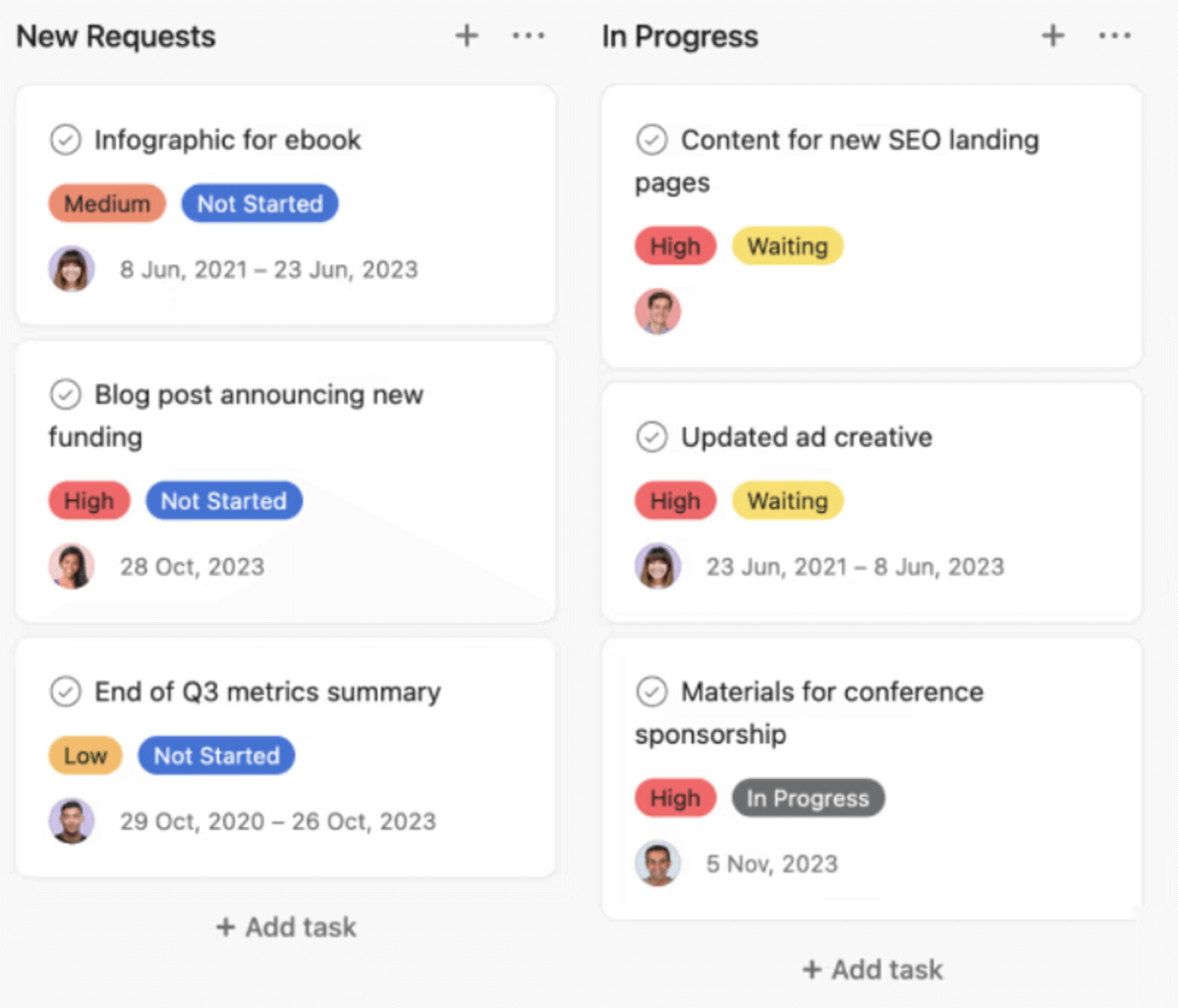
SOurce: asana
Asana is a solid choice for those looking for a centralized platform for their daily tasks, projects and collaborations. Users choose Asana because it offers a user-friendly interface and can be easily adapted to different project management styles.
Some users find the learning curve for advanced features in Asana to be steep, especially when it comes to setting up complex workflows or integrating with external tools.
Learn more in our guide to the top Asana alternatives.
3. Trello – Free Alternative to Teamwork for Simple Kanban
Trello is a simple and flexible work management tool that uses a Kanban-style board to organize tasks and projects. Some of the key features of Trello include:
- Project dashboards
- Collaboration
- Integrations
- Workflow automation

Source: trello
Trello is a good choice for those looking for a more visual approach to their project management. Customers like Trello’s simplicity and intuitive interface make it easy to get started and collaborate effectively, particularly for small teams or personal task management. But the simplicity has it’s downsides too.
If you want to tackle complex projects, Trello lacks certain advanced features – learn more in our Trello vs Asana vs ClickUp vs Monday breakdown.
4. Basecamp – Solid Substitute for Message-First Teams
Basecamp is a project management tool that offers a range of features to help teams collaborate effectively. Some of the key features of Basecamp include:
- Project Tracking
- Group Chat
- Client portal
- Document Management

source: basecamp
Basecamp is a fair option for companies looking for an all-in-one tool that makes team collaboration easier. Users like its focus on simplicity and the fact that Basecamp is a straightforward platform that helps teams stay organized.
The tool’s feature set may be considered limited for larger or more complex projects, as it lacks some advanced project management functionalities found in other tools.
Check out our list of alternatives to WorkflowMax to learn more about Basecamp and similar PM solutions.
5. Slack – Teamwork-Like Collaboration Layer for Real-Time Chat
Slack is a popular team communication tool that offers a range of features to help teams stay connected and collaborate effectively. Some of the key features of Slack include:
- Channels
- Direct Messaging
- File Sharing
- Integrations
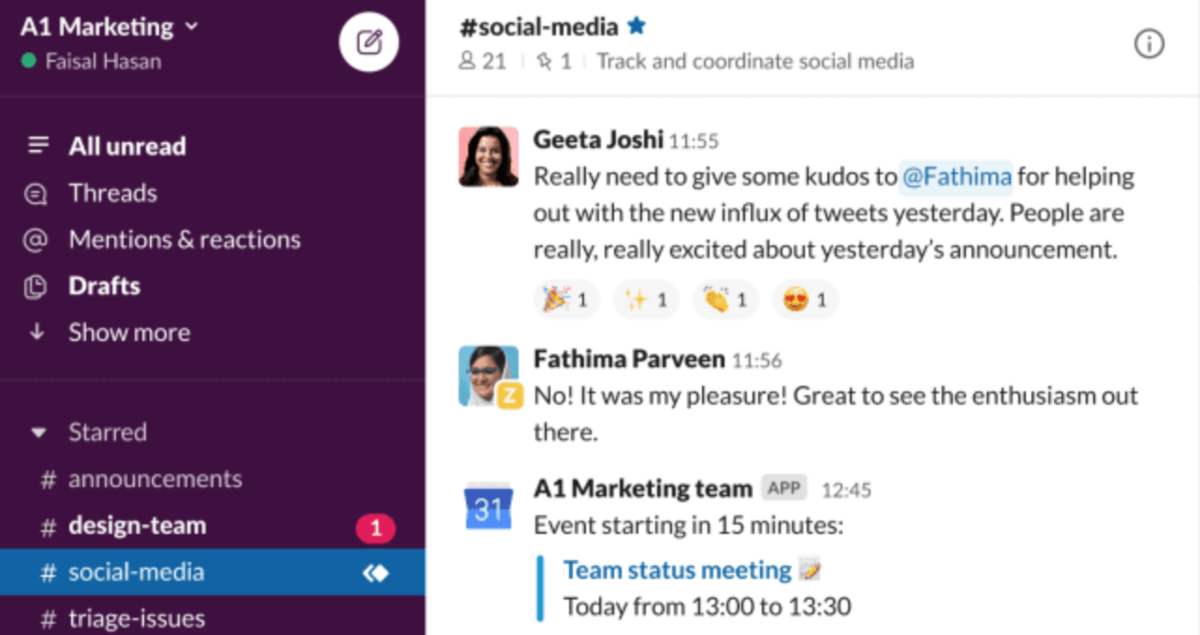
source: slack
Slack is a bit different from the other tools since it’s a team communication tool, but it has become essential for companies of all sizes. You can also look at ti more as a Teamwork companion rather than a full substitute.
It promotes efficient communication and collaboration by allowing teams to organize conversations into channels, easily search for information, and integrate with various other tools and services.
6. ClickUp – Highly Customizable Replacement
ClickUp is a powerful project collaboration software that offers a range of features to help teams collaborate effectively. Some of the key features of ClickUp include:
- Project and Task Management
- Time Tracking
- Customizable Templates
- Automation features

source: clickup
Clickup is a comprehensive tool that offers a wide range of features for business of all shapes and sizes. The scope of customization options makes it popular with teams that work on diverse projects and need many different workflows.
Some users may find ClickUp overwhelming due to its extensive feature set, requiring time and effort to fully explore and utilize its capabilities effectively which we highlighted in our comparison of Teamwork vs Clickup.
7. Workzone – Teamwork-Style Option for Approvals and Portfolios
Workzone is a task management tool that offers a range of features to help teams collaborate effectively. Some of the top features of Workzone include:
- Project and Task Management
- Time Trackings
- Reports and Analytics

source: workzone
Workzone is a good fit for those looking to streamline their workflow and centralize project information. It provides robust project tracking and reporting features, which in turn allows teams to gain insights into project status and resource availability.
Some users find the user interface of Workzone to be less intuitive compared to other tools, which may require additional time and training to become familiar with the platform.
Additionally, the visualization options are lacking, so it may be a better fit for big in-house teams of larger enterprises.
8. Monday.com – Visual Competitor with Strong Integrations
Monday.com is a team collaboration platform that enables users to work more effectively. Some of the key features of Monday.com include:
- Project Progress Tracking
- Customizable Workflows
- Automation
- Task prioritization
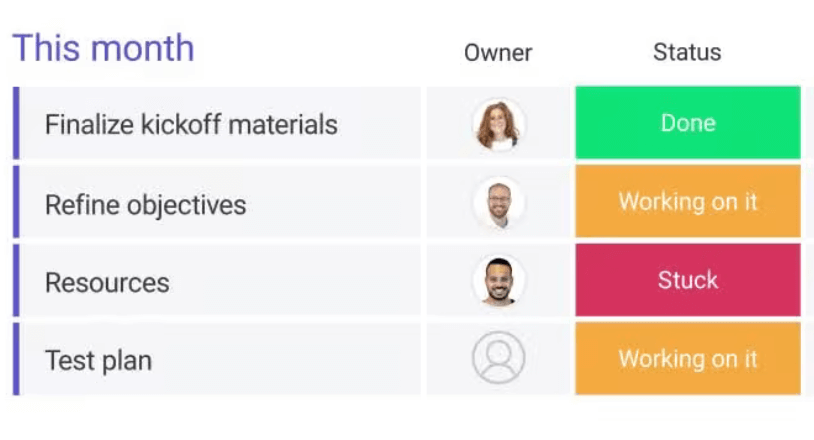
source: monday.com
Monday.com is another solid option for those leaning towards a visual project management tool.
The tool offers a high level of flexibility and customization, enabling teams to adapt the tool to their specific project management needs and visualize data in a way that suits their workflow (and if you’re interested in data visualization, you can check out Monday vs Notion).
On the other hand, it might not be the best fit for those looking for an out-of-the-box solution since it has a pretty steep learning curve.
9. Workamajig – A Good Alternative for Creative Agencies
Workamajig is a project management and collaboration tool designed specifically for creative agencies. Some of the key features of Workamajig include:
- Project and Task Management
- Resource Management
- Time Tracking
- Billing and Invoicing

source: workamajig
Workamajig provides specialized features for creative project management, such as project budgeting and invoicing integrations, which cater specifically to the needs of creative professionals.
Some users find the user interface of Workamajig to be outdated and less intuitive compared to more modern project management tools. This may require additional training or adjustment for new users.
Read more about Workamajig alternatives and benefits.
10. Avaza – Budget-Friendly Alternative to Teamwork with Time and Invoicing
Avaza is a collaborative platform that offers a range of features to help teams work together more effectively on simple projects. Some of the key features of Avaza include:
- Project Templates
- Time Management Feature
- Invoicing
- Collaboration

source: avaza
If you’re looking for a cloud-based PM tool, look no further. Avaza offers a comprehensive suite of features, including project management, time tracking, and financial management, making it a versatile tool for teams that require multiple functionalities in one place.
Still, some users may find that Avaza’s reporting capabilities are limited compared to more specialized project management tools. This could impact the depth of insights that can be generated from project data.
11. Easy Project – Classic PM-Focused Teamwork Equivalent with Gantt and Resources
Easy Project is an online project management tool that offers a range of features to help team members collaborate effectively. Some of the key features of Easy Project include:
- Project Management
- Task Management
- Time Tracking
- Reports and Analytics
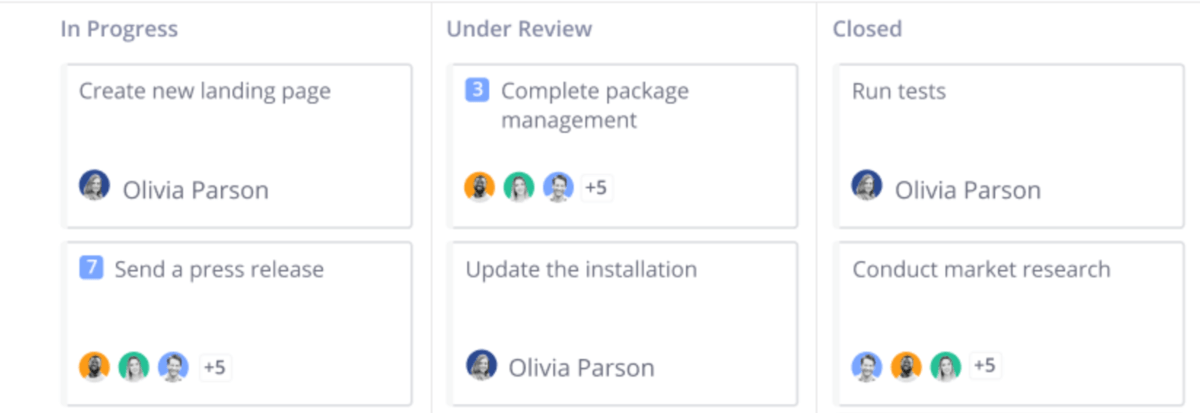
source: easy project
Easy Project is a fair choice for those looking for a bigger tool that’s able to handle more complex projects since it has an extensive feature set.
However, some users may find that the user interface of Easy Project is not as visually appealing or modern as other project management tools, which could impact the overall user experience.
Why Teams Look for Teamwork Replacements?
Teams look for Teamwork replacements because day to day work and the financials behind it live in different tools, which slows decisions and hides margins.
Below is a summary of the most common reasons show up most often in reviews and comparisons:
- Deeper resource planning is needed. Limited capacity views and no built in time off management can make availability and scheduling less accurate.
- Financials and forecasting fall short. Teams want live margin, stronger financial reporting, and clearer revenue forecasting across clients and projects.
- Too many add ons for core workflows. Advanced features often sit in higher paid plans, and some accounting connections require workarounds, so delivery and finance stay split.
- Portfolio level reporting is missing. Leaders need a consolidated picture of progress and profitability across accounts, not project by project spreadsheets.
- Reporting takes too much manual work. Teams look for dashboards they can trust and scheduled updates to Slack or email without copy paste.
- Interface friction adds up. Some users mention UI clutter and extra clicks at scale, and look for a simpler daily workflow.
- Sales to delivery is disconnected. Teams want a built in pipeline that feeds resourcing and budgets, instead of juggling separate tools.
We talk more about key features and best options in our big list of the best agency software.
Overview of the Best Teamwork Substitutes
Quick note: this overview focuses on pros, cons, and common use cases. We’re not listing pricing here.
| Tool | Best for | Pros | Cons | Common use cases |
|---|---|---|---|---|
| Productive | Teams that want an all in one platform | Projects plus financials in one place; strong reporting; resource planning; client access | Broad feature set needs onboarding | Agency or professional service delivery, retainers, portfolio reporting |
| Asana | Cross functional coordination at scale | Clear task orchestration; rules and workflows; solid integrations | Advanced automation can be complex | Team task orchestration, program tracking |
| Trello | Simple and free Kanban for small teams | Visual boards; quick onboarding; power ups | Limited for complex dependencies and scaling | Lightweight boards, personal and team tasking |
| Basecamp | Message first collaboration | Central communication; simple client portal | Limited PM depth for complex projects | Team comms with light projects |
| Slack | Real time communication layer | Channels, search, many integrations | Not a PM tool; notification overload risk | Handoffs and announcements alongside PM tools |
| ClickUp | Highly customized workspaces | Many features in one app; templates; automation | Can feel heavy and overwhelming | Custom workflows across teams |
| Workzone | Approvals and portfolios | Review workflows; templates; portfolio reporting | Older UI; setup can take time | Marketing approvals, portfolio rollups |
| monday.com | Visual boards across departments | Multiple views; wide integrations | Setup and governance needed at scale | Cross department workflows and dashboards |
| Workamajig | Creative agencies | Traffic management; estimates; billing tied to work | Dated UX; learning curve | Agency delivery with finance needs |
| Avaza | Budget friendly PM with time and invoicing | Time, expenses, invoicing in one place | Reporting depth can be limited | Small teams, service billing |
| Easy Project | Classic PM with WBS and resources | Gantt, WBS, resource planning | Heavier UI; complexity | Structured, plan driven projects |
Final Takeaway
At the end of the day, finding the right project management tool depends on the specific needs and preferences of your team or organization. It’s key for you to consider factors such as project complexity, team size, collaboration requirements, and budget when evaluating alternatives to Teamwork.
By carefully assessing the features and drawbacks of each tool, you can make an informed decision that aligns with your team’s goals and enhances collaboration and project success.
If you’re looking for an end-to-end agency management software, you might want to sign up for a short demo with Productive.
Connect With Agency Peers
Access agency-related Slack channels, exchange business insights, and join in on members-only live sessions.

